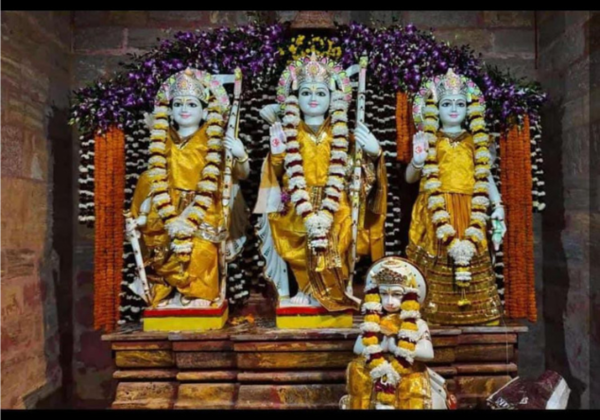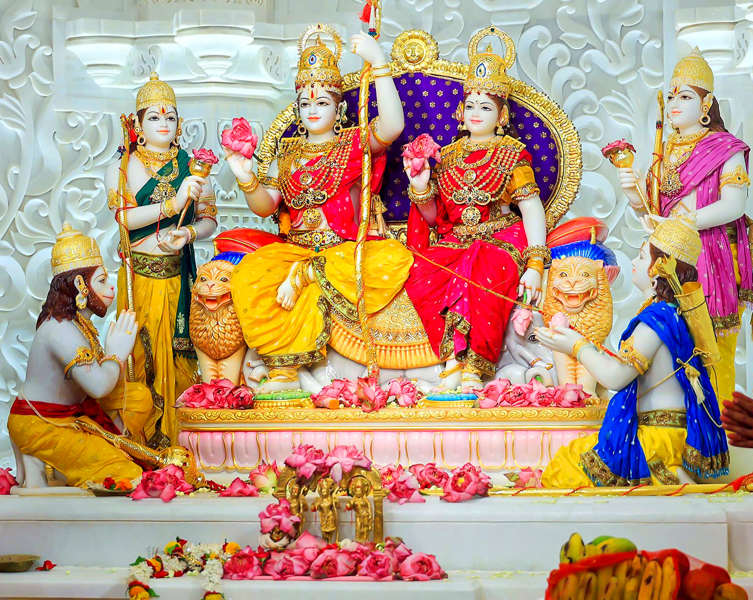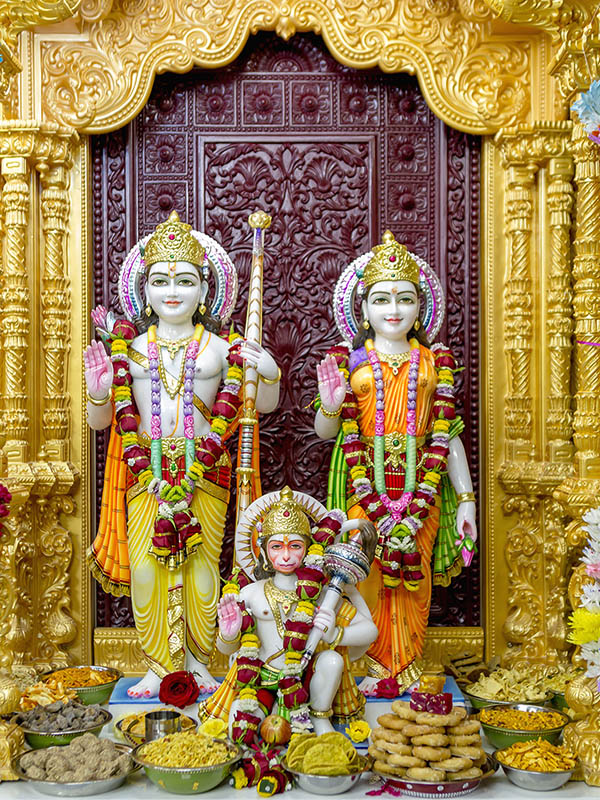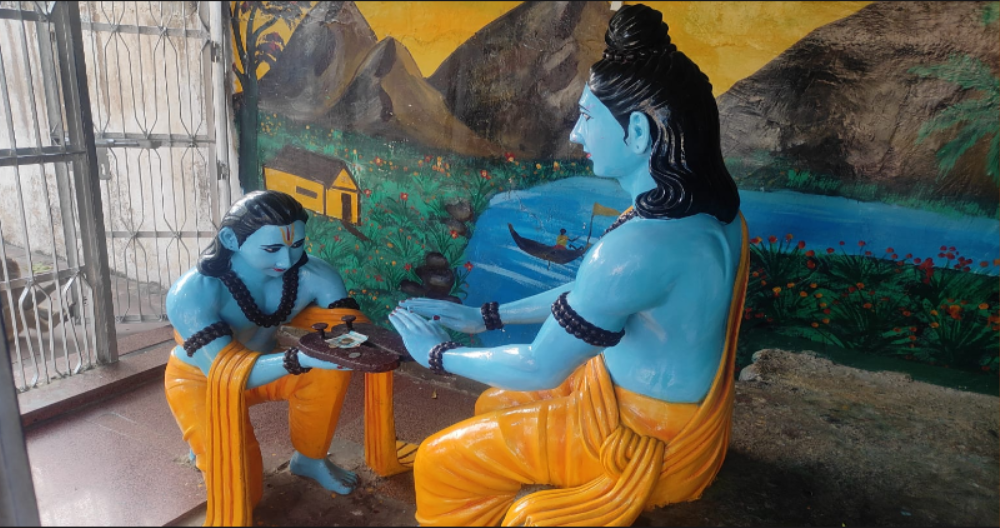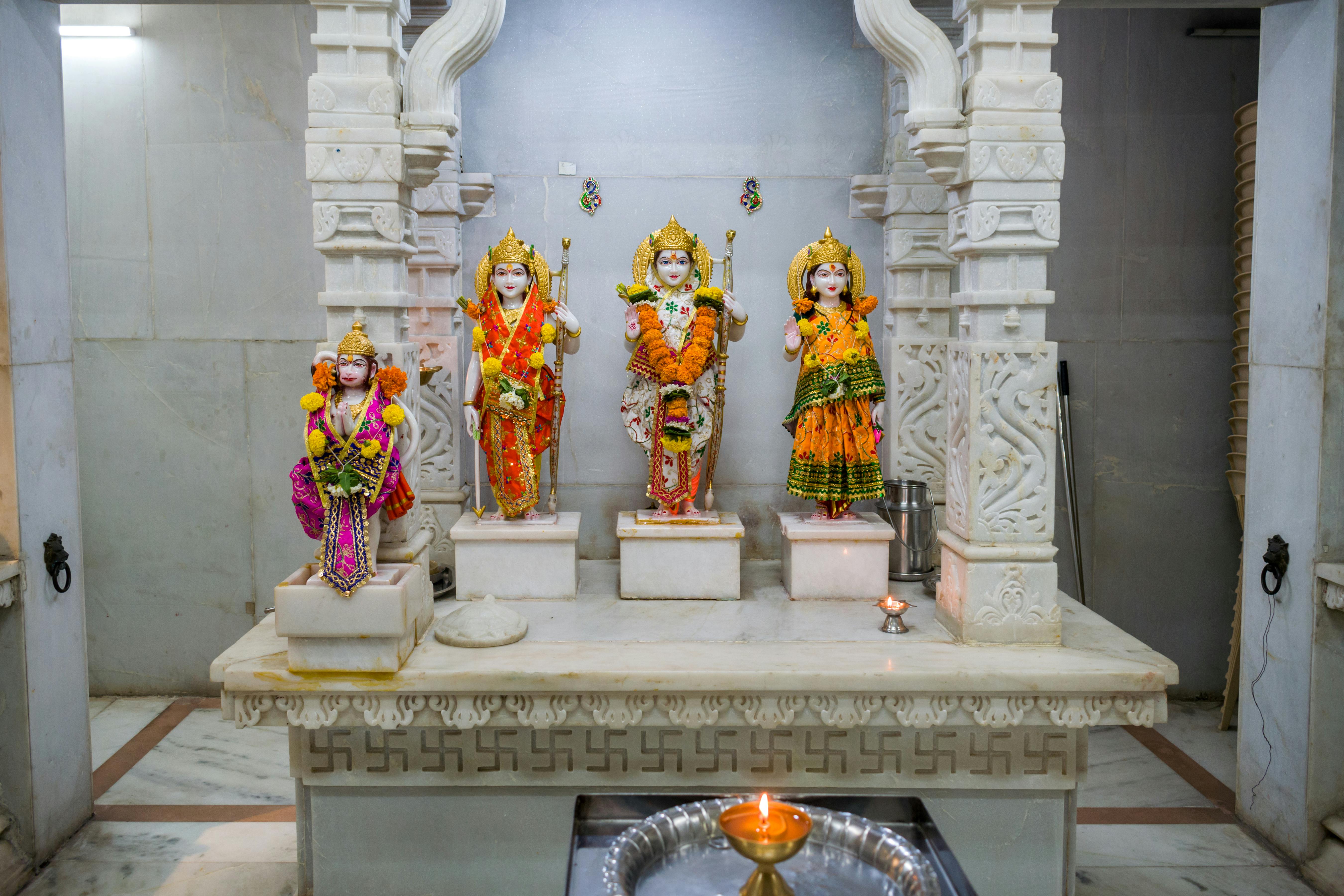In the sacred tale of the Ramayana, there is a significant moment of spiritual surrender that highlights the core of genuine devotion. The narrative of Swyamprabha, a dedicated yogini, imparts timeless lessons on humility, faith, and the infinite grace of the Divine.
The Divine Feet That Ferry Devotees Across
ममैतदेव रूप ते सदा भातु हृदालये।
राम ते पादयुगलं दर्शित मोक्षदर्शनम्॥ ६६
O best of Raghus, those who know your ultimate truth may understand it, but may your form forever dwell in my heart. O Rama! Today, I have witnessed your lotus feet, which provide salvation and assist us in crossing the river of the world and lead us on the correct path.
Adhyatma Ramayan
Swyamprabha begins her prayer with a lovely metaphor, comparing Lord Ram’s holy feet to a boat that can carry devotees across the stormy river of worldly life. These divine feet, she claims, illuminate the path of righteousness, truth, and moral integrity. In her deep humility, she sees a striking truth: those who are proud, whether because of their wealth, virtues, knowledge, or worldly accomplishments, cannot truly approach the Lord. Why is this? Because the Divine is especially for the humble, the poor, and those who have little. The Lord is the ultimate refuge for those who possess only faith.
Beyond Measurement and Definition
निवृत्तगुणमार्गाय निष्किक्षनधनाय ते ॥ ६८ ॥
नमः स्वात्माभिरामाय निर्गुणाय गुणात्मने । कालरूपिणमीशानमादिमध्यान्तवर्जितम् ॥ ६९ ॥सम॑ चरन्तं सर्वत्र मन्ये त्वां पुरुष परम्। देव ते चेष्टितं कश्निन्न वेद नृविडम्बनम्॥ ७० ॥
I humbly bow to You, who transcend qualities, the source of all conclusions, who submit to Your own essence, and who are both Nirguna (without attributes) and Saguna (with attributes). I see You as time itself, the ruler of everything, with no start, middle, or finish, present everywhere, and the Supreme Being. O Lord! No one can grasp the true nature of the divine actions You carry out while taking on human form.
Swyamprabha’s prayer reaches mystical heights as she attempts to express the inexpressible. She understands that the Lord exists beyond ordinary virtues and qualities. He is both Nirgun (formless, without attributes) and Sagun (with form and attributes), transcendent and immanent at the same time.
She sees Him as the master of Time itself, with no beginning, middle, or end. He is the all-encompassing supreme consciousness, the macrocosmic presence that fills every part of existence. Yet His divine play (leela) as a human being remains a captivating mystery that no human mind can fully grasp.
The Impartial Divine
न तेडस्त कश्चिदयितो द्वेष्यो वापर एव च । त्वन्मायापिहितात्मानस्तवां पश्यन्ति तथाविधम्॥ ७१ ॥अजस्याकर्तुरीशस्य देवतियडलरादिषु ।जन्मकर्मादिक॑ यघ्यत्तदत्यन्तविडम्बनम् ॥ ७२
O Lord, no one is cherished, despised, or indifferent to You. Those whose hearts are shrouded by your illusion view you according to their own sentiments.॥71॥ You are timeless, not a doer, and the Supreme Being. Your manifestations and actions as deities, creatures, and people are all Your magnificent play.॥72॥
One of the most lovely parts of her prayer is the acknowledgment of divine balance. The Lord has no favorites, no enemies, and no one He ignores. He sees everyone with the same compassion. It is only our own misconceptions, the veils of Maya that obscure our inner sight, that lead us to view Him through our narrow, biased lenses.
Swyamprabha realizes that the Lord does not perform actions in the ultimate sense and does not take birth in the usual way. His different forms as gods, animals, or humans, along with all the actions done in those forms, are part of His mysterious divine play, which is beyond ordinary understanding.
The Divine Incarnation and True Knowledge
त्वामाहुरक्ष जात॑ कथाश्रवणसिद्धये । केचित्कोसलराजस्थ तपसः: फलसिद्धये ॥ ७३
कोसल्यया प्रार्थ्यमानं जातमाहु: परे जना: । दुष्टराक्षसभूभारहरणायार्थिती. विभुः ॥ ७४ ॥
ब्रह्मणा नररूपेण जातोह्यमिति केचन। श्रृण्वन्ति गायन्ति चर ये कथास्ते रघुनन्दन ॥ ७५
पश्यन्ती तब पादाब्ज॑ भवार्णवसुतारणम् । त्वन्मायागुणबद्धाहं व्यतिरिक्ते गुणाअश्रयम् ॥ ७६ ॥
कथं त्वां देव जानीयां स्तोतुं बाविषयं विभुम । नमस्यामि रघुश्रेष्ठ बाणासनशरान्वितम् । लक्ष्मणेन सह भ्रात्रा सुग्रीवादिभिरन्वितम ॥| ७७
It is said that you, the eternal God, took form just to spread His sacred and divine tales. Some believe you were born to reward the penance of King Dasaratha, the king of Kosala. Some claim you came at Kausalya’s request; others think that, even though you are everywhere, you took human form at Lord Brahma’s request to eliminate the demons that burden the earth. ‘O son of Raghunandan! Those who hear or share your stories will surely see your lotus feet, like a boat that helps one cross the ocean of the world. O Lord! I am influenced by the qualities of Maya; how can I understand you, who are entirely different from those qualities and their foundation? Likewise, since you cannot be described in words, how can I even praise you, the great one? Therefore, I only bow down to you, the best of Raghu, who wields bow and arrow, along with Lakshmana and Sugriva, etc.
Why does the Lord take birth? Swayamprabha offers several traditional reasons: to highlight the significance of listening to His holy stories, to reward King Dasaratha’s penances, to respond to Mother Kaushalya’s prayers, or to ease the Earth’s burden by vanquishing evil demons at Brahma’s request.
Each reason holds some truth, but none fully explains the mystery of divine incarnation. The Lord’s actions are always amazing and beyond human understanding.
In a moment of deep self-reflection, Swyamprabha acknowledges her own limitations. She admits that she is also under the influence of Maya. How can she truly know or honor the One who is entirely beyond Maya? Since the Lord surpasses the limits of speech and language, how can she properly pray?
This acknowledgment is not a failure but the greatest wisdom. True devotion understands its own insignificance in the face of the infinite. Still, in her humility, she shows her respect to the Lord who wields the bow and arrow, along with His brother Lakshmana and devotees like Sugriva.
The Simplest Yet Most Profound Wish Granted
एवं स्तुतो रघुश्रेष्ट: प्रसन्न: प्रणताघहत । उवाच योगिनी भक्तां किते मनसि काछ्वितम् ॥
By her praising Him in this manner, Sri Raghunath, the destroyer of all sins, was very pleased and said to that devoted Yogini, “What is your heartfelt desire?”
She said to Sri Raghunath with utmost devotion-
Her answer was simple yet deeply spiritual. She does not ask for worldly boons, supernatural abilities, or material riches. Her desires were:
Unwavering devotion to the Lord in every birth
Association with devotees rather than worldly people
Constant remembrance of the Lord’s name—”Ram, Ram”
Continuous contemplation of His beautiful form with Sita and Lakshmana
She desires nothing more than pure and selfless devotion. In this prayer, we see the height of spiritual longing, the wish for God alone, not for what God can provide.
Lord Ram, the compassionate one who absolves the sins of those who surrender to Him, grants her wishes with tender grace: “So shall it be.”
Swayamprabha’s tale reveals timeless truths:
Genuine devotion needs humility. Being proud of our achievements, wealth, or knowledge builds walls between us and the Divine. The Lord is closest to those who come with open hands and humble hearts.
The Divine goes beyond all categories. Although we try to define God with different traits and qualities, the Ultimate Reality is beyond all thoughts and words.
Simple devotion is greater than complicated theology. Swyamprabha’s prayer, even with its deep philosophy, ends with the simplest desire: to always remember God and be with His followers.
Grace reaches sincere seekers. When devotion is genuine and selfless, divine grace flows generously. The Lord’s joy in Swyamprabha’s prayer shows how true spiritual desire connects with the Divine.
Freedom comes from remembrance. The way to true liberation is not through complicated rituals or secret practices, but through loving and consistent remembrance of the Divine presence.

